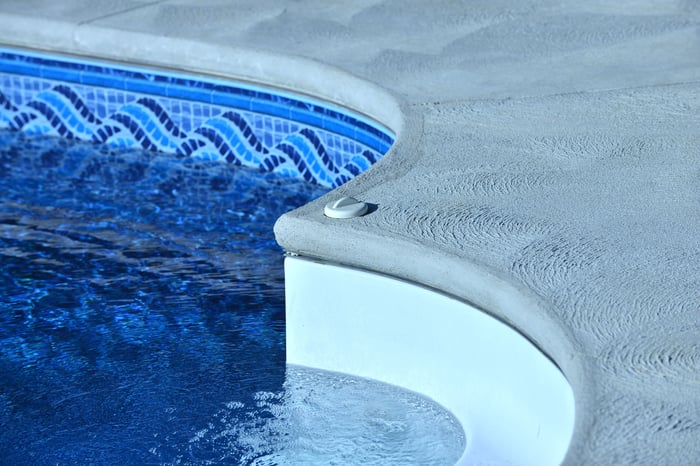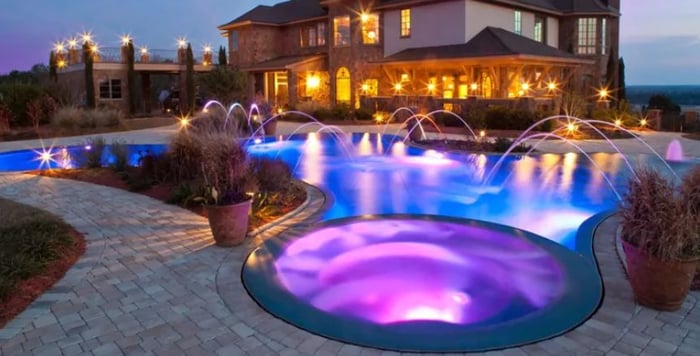An inground pool is the ultimate in backyard upgrades. If you've always wanted one, now may be the time. Prices have fallen during the recession by up to 30%. Nevertheless, it remains a big investment, so it's important to make smart choices with regard to size, shape, site selection, and type.
If you ask three companies that each build a different type of pool "which pool is the best", you will get three answers that are all the same; their pool is the best! Everyone has reasons for liking one pool type over another. That's whats so great about having options, there's something for every one! The truth is, each pool type has their own advantages and disadvantage.
Vinyl VS. Fiberglass VS. Concrete: Pros, Cons, and More!
Inground Vinyl Liner Pool
This type of pool is an economical way to get an inground pool.
Inside a suitable excavation, a frame of wood, plastic or metal is erected. The most stable systems are set in a concrete footing. Wall panels are then fastened to the framing, plumbing is installed, and a sand base is laid. A heavy-duty vinyl liner is fastened to the top of the frame and what remains of the hole is back-filled. Masonry coping is installed over the top of the wall.
Shape/Depth Customization: Unlike a fiberglass pool, vinyl liners can be customized into any shape or depth. So whether you want an ‘L' shaped pool, a classic Roman, a Grecian, etc; a vinyl liner pool will fit the bill. Options available are wide open and almost limitless. I have seen vinyl liner pools constructed in a way where they look like nearly identical to a gunite pool.
One of the nice things about the liner pool is the softness/smoothness of the liner. Having swam in these pools, I can tell you there is not any surface you can get in a gunite pool that will match the vinyl liner pools. In addition, the surface is not as porous as a plaster finish on a gunite pool. So these type of pools actually use less sanitizer than a gunite pool - somewhere around 25% less on average. The non-porous surface leads to less chemical usage during the season and therefore money savings as well.
Lastly, the vinyl liner pool can be a DIY project which would lead to even more savings, unlike the other two pools. Most certainly, you can't go wrong with a vinyl liner pool. It is the most cost effective, produces fewer time restraints on installation and can be a DIY project for a big savings.
Fiberglass
The inground fiberglass pool has some of the same benefits as the vinyl liner pool. It has a very smooth, non porous surface like the liner pool. So the same chemical benefits apply, if the pool is maintained properly. Lower maintenance is what originally spawned the fiberglass pool movement throughout the United States and the rest of the world.
Fiberglass pools are pre-molded in a variety of shapes and sizes. They are manufactured with steps, benches, and swim-outs already in place. After the hole has been dug, plumbing installed, and sand base laid, the fiberglass shell is lowered into the hole and leveled. To avoid bowing, filling the pool with water and back filling with sand must be done simultaneously. No framing is required.
Fiberglass pools are a mid-range price usually between the other two types of pools.
Gunite
Shapes and options are limited only by your budget When properly installed they are very nice. With a gunite pool, the structure is actually steel-reinforced gunite while the interior is usually plaster or pebble.
Gunite pools are made by shooting a mix of cement, sand, water, and aggregate from a pneumatic applicator at high speeds against the earthen walls and base of the pool excavation and around a grid woven of steel rebar (reinforcing bar). Multiple passes are necessary to build the mixture to the desired thickness. The concrete must be troweled smooth before it sets, and afterwards a coat of plaster is applied. This interior surface is porous unlike the other two pools and water chemistry, as in all pools, is key to keeping algae from growing and the health of the pool in good working order.
The gunite swimming pool carries the highest price range of the three pools.
Vinyl VS. Fiberglass VS. Concrete: Pros, Cons, and More!
Disadvantages To Look For In Swimming Pools
The Vinyl Liner Pool has the potential of a replacement liner cost that could vary in price range, but cost can be reduced by installing the liner yourself. The up-side to this is that with every liner change you get a new, crisp looking swimming pool. Liners can last anywhere from 5 years up to 25 years. Water chemistry and proper use is key to helping your liner last.
The Fiberglass pool is limited in size. Primarily due to the fact that they must be hauled to your house on a truck. This limits the width of the pools. I think the widest pool that is available is around 17'. One other potential problem is the top portion that is exposed to the sun. I have seen these portions oxidize due to sun exposure. Unlike the vinyl liner pool there is no liner to replace, but if anything was to fall in the fiberglass pool and nick or scratch the surface, then you are looking at a resurfacing cost. The initial price of fiberglass pools can be a drawback. When comparing a vinyl liner pool with a fiberglass pool, one will find that a fiberglass pool is initially 4-9k more.
In a Gunite pool, if chemicals get out of balance, the plaster can become rough. Over time, some of the cement in the plaster mix can be eaten away, exposing the marble. This can be like sand paper on your feet. If this happens, you will need to re-plaster your pool. The good news is that if properly maintained, the plaster can last as long as 20 years. What I have seen is an average lifespan of 15 years before re-plastering. You can also opt for a pebble finish, although not as smooth as plaster. The exposed pebbles will stay the same throughout the life of the pebble. Gunite pools take the longest time to build. While the liner pool and fiberglass pools are installed in 1-2 weeks. The gunite pool can take 4-6 weeks or longer to build. On the plus side structurally, when installed properly, gunite pools are the strongest.
If you still have more questions on pool types, let us know! We'd be more than happy to help you plan and design your dream backyard!
Additional resources for your pool buying journey:




